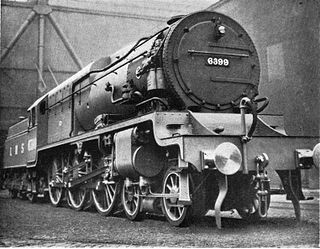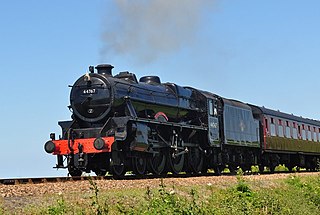Related Research Articles

The London, Midland and Scottish Railway (LMS) Princess Royal Class is a class of express passenger 4-6-2 steam locomotive designed by William Stanier. Twelve examples were built at Crewe Works, between 1933 and 1935, for use on the West Coast Main Line. Two are preserved.

The London Midland and Scottish Railway (LMS) Coronation Class is a class of express passenger steam locomotives designed by William Stanier. They were an enlarged and improved version of his previous design, the LMS Princess Royal Class, and on test were the most powerful steam locomotives ever used in Britain at 2,511 dbhp. The locomotives were specifically designed for power as it was intended to use them on express services between London Euston and Glasgow Central; their duties were to include the hauling of a proposed non-stop express, subsequently named the Coronation Scot. The first ten locomotives of the Coronation class were built in a streamlined form in 1937 by the addition of a steel streamlined casing. Five of these ten were specifically set aside to pull the Coronation Scot. Although a later batch of five unstreamlined locomotives was produced in 1938, most of the ensuing Coronation class were outshopped as streamliners. Eventually, from 1944 until production ended in 1948, all-new engines would be built in unstreamlined form and all the streamliners would have their casings removed. The very last of the 38 locomotives was completed in 1948.
The Turbomotive was a modified Princess Royal Class steam locomotive designed by William Stanier, inspired by the Ljungström locomotive, and built by the London, Midland and Scottish Railway in 1935. It used turbines instead of cylinders. It was later rebuilt as a conventional locomotive 46202 Princess Anne.
Sir William Arthur Stanier, FRS was a British railway engineer, and was chief mechanical engineer of the London, Midland and Scottish Railway.
The London, Midland and Scottish Railway had the largest stock of steam locomotives of any of the 'Big Four' Grouping, i.e. pre-Nationalisation railway companies in the UK. Despite early troubles arising from factions within the new company, the LMS went on to build some very successful designs; many lasted until the end of steam traction on British Railways in 1968. For an explanation of numbering and classification, see British Rail locomotive and multiple unit numbering and classification.
Henry George Ivatt, known as George Ivatt, was the post-war Chief Mechanical Engineer of the London Midland and Scottish Railway. He was the son of the Great Northern Railway locomotive engineer Henry Ivatt. George Ivatt was born in Dublin, Ireland, and educated at Uppingham School, England.
Robert Arthur "Robin" Riddles, CBE, MIMechE, MinstLE was a British locomotive engineer.

The steam locomotives of British Railways were used by British Railways over the period 1948–1968. The vast majority of these were inherited from its four constituent companies, the "Big Four".

The London Midland and Scottish Railway (LMS) No. 6399 Fury was an unsuccessful British experimental express passenger locomotive. The intention was to save fuel by using high-pressure steam, which is thermodynamically more efficient than low-pressure steam.

Crewe Works is a British railway engineering facility located in the town of Crewe, Cheshire. The works, which was originally opened by the Grand Junction Railway in 1840, employed up to 20,000 workers at its peak. In the 1980s, a lot of the engineering works were closed. Much of the site has been redeveloped but the remaining parts are owned and operated by French-owned multinational rolling stock manufacturer, Alstom SA.

The Coronation Scot was a named express passenger train of the London, Midland and Scottish Railway inaugurated in 1937 for the coronation of King George VI and Queen Elizabeth which ran until the start of the war in 1939. It ran on the West Coast Main Line between London and Glasgow, stopping at Carlisle for crew change and to pick up and set down passengers to and from London only. The service was designed to compete with the rival services on the East Coast Main Line, for prestigious London to Scotland traffic. It was scheduled to complete the journey from London to Glasgow in 6 hours 30 minutes.

LMS Princess Coronation Class 46233 Duchess of Sutherland is a steam locomotive built in 1938 for the London, Midland and Scottish Railway (LMS) at Crewe Works to a design by William Stanier. It is a 4-6-2 Pacific locomotive built as part of the LMS Coronation Class for its express passenger services, including the Royal Scot service from London to Glasgow.

London Midland and Scottish Railway (LMS) Stanier Black Five, LMS number 4767, BR number 44767 is a preserved steam locomotive. In preservation it has carried the name George Stephenson though it never bore this in service with British Railways.

London Midland and Scottish Railway (LMS) Royal Scot Class 6100Royal Scot is a preserved British steam locomotive.

6201 Princess Elizabeth is a preserved steam locomotive in England. It is one of two preserved LMS Princess Royal Class; the other being 46203 Princess Margaret Rose.

London Midland and Scottish Railway (LMS) Princess Royal Class No. 6203Princess Margaret Rose is a preserved British steam locomotive.

The London and North Western Railway (LNWR) Claughton Class was a class of 4-cylinder express passenger 4-6-0 steam locomotives.

The London Midland and Scottish Railway (LMS) Rebuilt Jubilee Class consisted of two 4-6-0 steam locomotives.

No.5551 The Unknown Warrior is a "rebuilt" or replica LMS Patriot Class steam locomotive which is under construction in the Midland Railway – Butterley's West Shed.
The London Midland and Scottish Railway and its successor British Railways built 52 express passenger steam locomotives with a pacific 4-6-2 wheel arrangement. These were to four classes - the LMS Princess Royal Class (1933-1935), LMS Turbomotive, later rebuilt as Princess Anne, and the LMS Coronation Class (1937-1948). All were built at Crewe Works. They were used principally on express passenger trains on the West Coast Main Line between Euston and Glasgow.
References
- ↑ "No. 6207; A Study in Steel (1935)". British Film Institute . Retrieved 26 July 2022.
- 1 2 "6207, A Study In Steel". Retrotechtacular. 7 June 2016.
- 1 2 Branch, Ben (27 October 2013). "No. 6207 A Study in Steel - Free Full Length Film". Silodrome. Retrieved 12 June 2019.